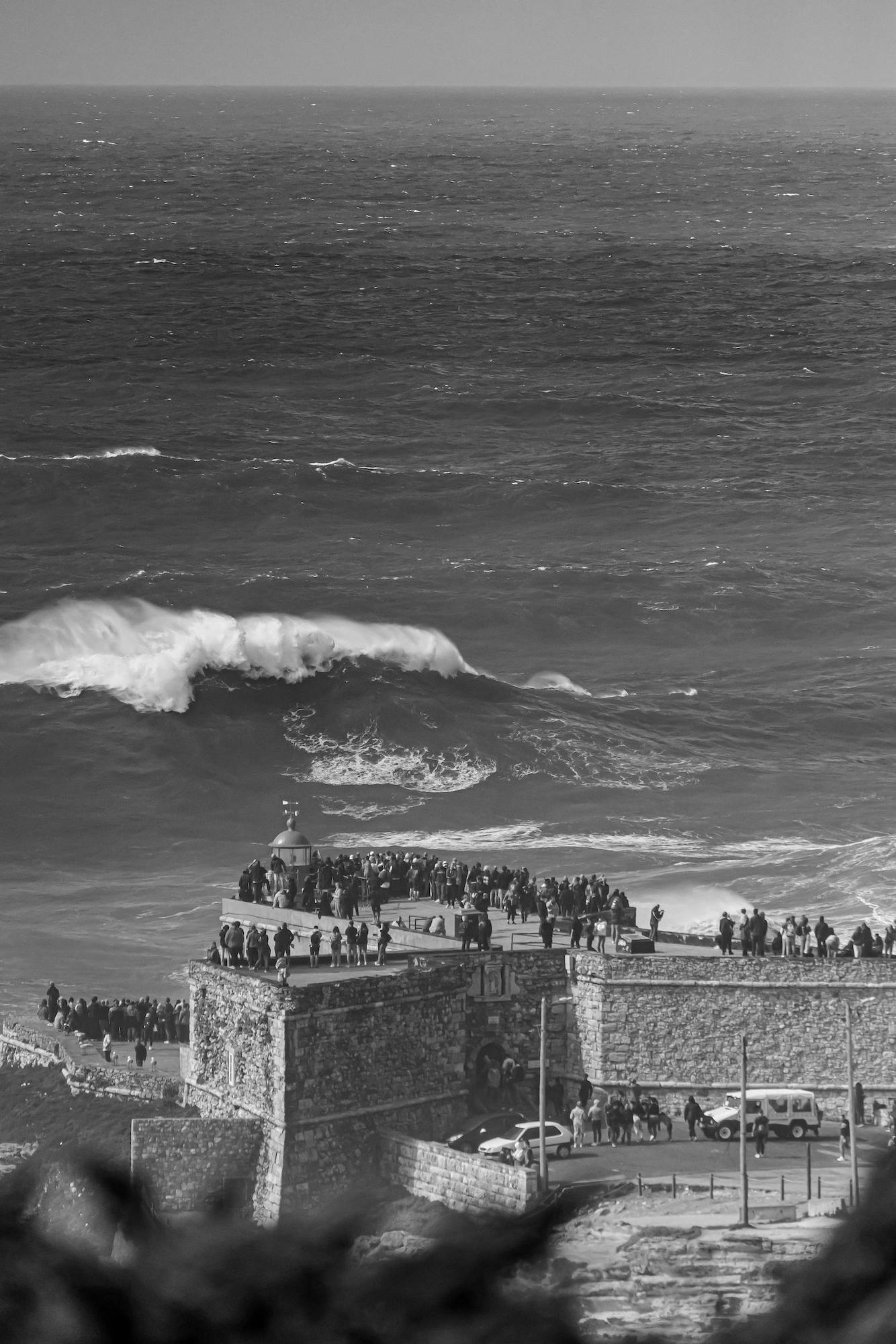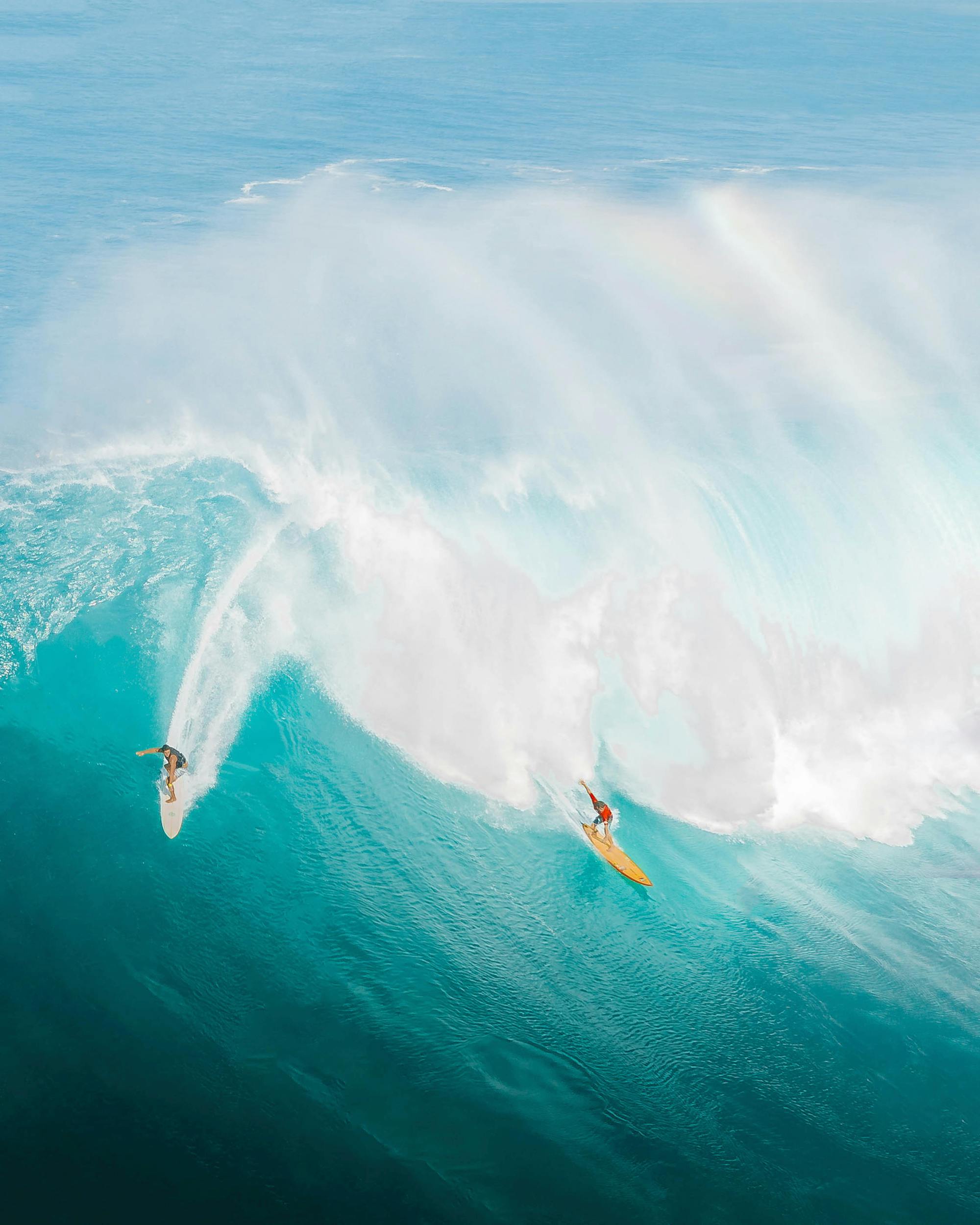Big wave surfing and
the largest waves in the world
Lesson 33
- Written by Emilia
- Published June 22, 2024
Post contents
Introduction
Big wave surfing represents the pinnacle of surf culture, putting surfers to the ultimate test of skills and bravery. Understanding big wave surf culture is like peeking into the heart of the sport. Let’s take a deeper dive into the world of big wave surfing and explore where you can find the largest waves in the world.

About big wave surf culture
Big wave culture is a unique and intense subculture within surfing, marked by a blend of extreme courage and respect for the ocean’s power. It revolves around surfing waves that can reach extreme heights, often exceeding 60 feet (18 meters). It’s a thrilling and daring part of surfing culture, where surfers chase some of the largest waves in the world.
Big wave surfing pioneers
Big wave surfing traces its roots back to the 1950s and 60s, with surfers like Greg Noll and Eddie Aikau. These pioneers braved uncharted waters with minimal equipment, driven by a pure passion for surfing.
Well-known big wave surfers in modern time
Today, surfers like Laird Hamilton, Kai Lenny, and Maya Gabeira push the boundaries even further. With advanced equipment and training, they surf waves that are often over 60 feet (18 meters) tall. The biggest wave efter surfed was 86 feet (26 meters) tall, and was surfed by Sebastian Steudtner.
The largest wave efter surfed, by Sebastian Steudtner at Praia do Norte in Nazaré, Portugal
Top 5 most famous largest waves in the world
1. Nazaré, Portugal
Nazaré is home to some of the largest waves in the world, thanks to the underwater Nazaré Canyon. Waves here can reach up to 100 feet (30 meters). The sight of these monstrous waves crashing against the cliffs is both terrifying and mesmerizing.
2. Jaws (Peahi), Maui, Hawaii
Jaws is known for its fast, powerful waves that can reach heights of 60 feet (18 meters) or more. This spot demands the highest level of skill and bravery from surfers, as the waves break with incredible force.
3. Mavericks, California, USA
Located off the coast of Northern California, Mavericks is famous for its cold water and some of the largest waves in the world that can exceed 60 feet (18 meters). This wave breaks over a shallow reef, making it one of the most dangerous surf spots in the world.
4. Waimea Bay, Oahu, Hawaii
Waimea Bay is one of the original big wave surf spots and has a legendary status in the surfing world. Waves here can reach up to 50 feet (15 meters), and the spot is famous for hosting the Eddie Aikau Big Wave Invitational.
5. Teahupo'o, Tahiti
Teahupo’o is known for its incredibly thick, heavy waves that can reach up to 30 feet (9 meters). The reef here is extremely shallow, adding to the danger and excitement.

A list of other well-known large-wave spots
6. Cortes Bank, San Diego, California, USA
Cortes Bank is a submerged island 100 miles off the coast of San Diego, producing waves that can be up to 100 feet (30 meters). It’s one of the most remote and legendary big wave spots with some of the largest waves in the world.
7. Belharra, La Côte Basque, France
Belharra produces massive waves that can exceed 60 feet (18 meters), breaking over a deep reef. It’s one of Europe’s most renowned big wave spots, attracting elite surfers from around the world.
8. Mullaghmore Head, Donegal Bay, Ireland
Mullaghmore Head offers some of the heaviest and most powerful waves in Europe, with swells that can reach over 50 feet (15 meters). The cold water and rugged coastline add to the challenge and appeal.
9. Dungeons, Cape Town, South Africa
Dungeons is notorious for its icy waters, strong currents, and waves that can reach up to 60 feet (18 meters). This break is located near the famous Sentinel Mountain and demands the utmost respect from surfers.
10. Puerto Escondido, Mexico
Puerto Escondido, often referred to as the “Mexican Pipeline,” is famous for its powerful beach break waves that can reach up to around 30 feet (9 meters). The waves here are fast, hollow, and extremely challenging.
11. Cloudbreak, Fiji
Cloudbreak is known for its long, powerful left-hand waves that can reach up to around 30 feet (9 meters). This reef break is located on a remote island and is considered one of the best big wave spots in the world.
12. Shipstern Bluff, Tasmania, Australia
Shipstern Bluff, also known as “Shippies,” is notorious for its unpredictable and challenging waves that can reach up to around 30 feet (9 meters). The wave features a unique and dangerous “step” that adds an extra layer of difficulty.
13. Punta de Lobos, Pichilemu, Chile
Punta de Lobos is a premier big wave spot in South America, with waves that can reach up to around 30 feet (9 meters). The long left-hand point break attracts surfers from around the world, and it’s known for its powerful and consistent swells.
14. Todos Santos (Killers), Baja California, Mexico
Todos Santos is famous for its giant waves that can reach over 60 feet (18 meters). This offshore reef break is known for its powerful and unpredictable swells.
15. Pico Alto, Punta Hermosa, Peru
Pico Alto is the largest wave in South America, with waves that can reach up to around 40 feet (12 meters). This spot is known for its long, powerful waves and is a key location in the big wave surfing circuit.
16. Ghost Tree, Pescadero Point, California, USA
Ghost Tree is located near Pebble Beach and is known for its extremely heavy waves that can reach up to 60 feet (15 meters), making it one of the spots with the largest waves in the world. The rocky bottom and cold water make it one of the most challenging big wave spots.

The gear and techniques used in big wave surfing
Surfing the largest waves in the world requires specialized equipment and techniques. Here are a few essentials:
1. Surfboards
Big wave surfboards, often called “guns,” are longer and thicker than typical surfboards, providing the stability and paddling power needed to catch large waves.
2. Safety gear
Surfers use inflatable vests and helmets to protect themselves from the power of the waves and the rocky reefs below.
3. Jet skis
In many big wave spots, surfers are towed into the waves by jet skis. This tow-in surfing allows them to catch waves that are too large to paddle into. They are also used to pick up surfers who have wiped out.
4. Training
Big wave surfers undergo rigorous physical and mental training. Breath-hold exercises, strength training, and practice in rough ocean conditions are crucial for survival.
The thrill and the risks of big wave surfing
Big wave surfing is a high-stakes game. The thrill of riding a giant wave comes with significant risks, including the possibility of severe injury or even death. Surfers must be prepared to handle extreme situations, such as being held underwater for extended periods or navigating through rocky reefs.
However, for many, the rewards outweigh the risks. The feeling of conquering a giant wave is unparalleled, providing a sense of achievement and connection to the ocean that few other experiences can match.

Lesson quiz: test your knowledge

Time's up
I’d love to hear your thoughts on this post! Whether you have suggestions for improvement, want to share what you liked, or have any questions, feel free to leave a comment below. Your feedback helps me create better content for all aspiring surfers!